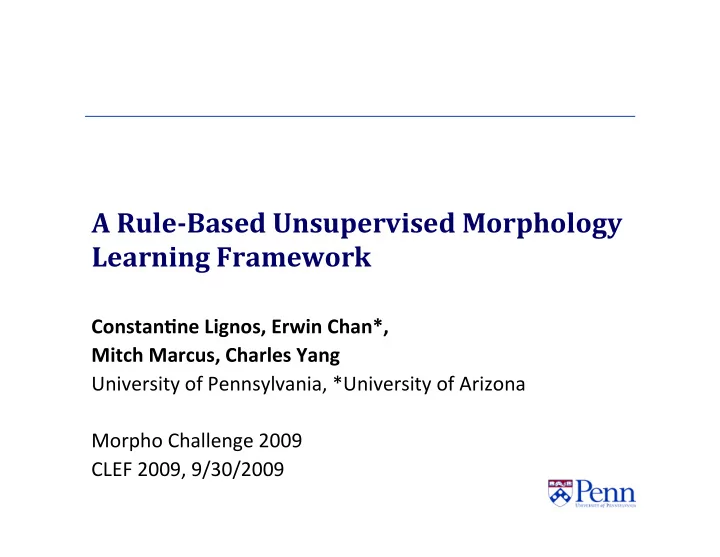

A RuleBased Unsupervised Morphology Learning Framework Constan'ne Lignos, Erwin Chan*, Mitch Marcus, Charles Yang University of Pennsylvania, *University of Arizona Morpho Challenge 2009 CLEF 2009, 9/30/2009
De=ining the Task • Applica'on of a language acquisi'on model as a morphological analyzer • How do we define an acquisi'on model? • CogniBvely moBvated‐ the representaBons it learns are linguisBcally moBvated and cogniBvely useful • Designed for a child’s input‐ Small amounts of sparse data received in an unsupervised fashion • Not looking to create a fully psychologically plausible algorithm • While the structures learned are plausible, some parts of the algorithm are computaBonally expensive for the sake of simplicity 9/30/2009 CLEF 2009 Workshop 2
The Learning Model: Chan (2008) • Structures and Distribu'ons in Morphology Learning • Provides: • RepresentaBon of morphology‐ Base and Transforms Model • Simple bootstrapping algorithm for learning bases and transforms in an unsupervised fashion • Enhancements needed for Morpho Challenge: • AdaptaBon to larger/noisier corpora • Morphological analysis output • Support for mulB‐step derivaBons 9/30/2009 CLEF 2009 Workshop 3
Distribution of In=lected Forms Log(freq) Lemma Inflec'on Spanish newswire verbs (2.5 M) Aug 17, 2007 Univ. of Tokyo 4
Base and Transforms Model • Within each syntac'c category, the most common inflected form is consistent • Instead of relying on an abstract stem, we have a “base” form that we can easily iden'fy‐ the most common inflec'on in each category • To model a derived form, apply a transform to a base: RUN + ($, s) = runs MAKE + (e, ing) = making Note: $ is used to represent a null affix 9/30/2009 CLEF 2009 Workshop 5
Base and Transforms Model • The learner will learn a set of rules (transforms) and the word pairs they apply to (base‐derived pairs) Baker Bakers BAKE + ER BAKE + ER+ S ($, er) ($, s) Bake Baking BAKE BAKE + ING (Base) (e, ing) Bakes BAKE + S ($, s) 9/30/2009 CLEF 2009 Workshop 6
The Algorithm: Sets • A word belongs to one of three sets at any 'me: • Unmodeled‐ All words begin in this set • Base‐ Words that are used as a base in a transform and are not derived from anything else • Derived‐ Words that are derived from a base word or another derived word Unmodeled Base Derived Bakes Bake Baker Bakers 9/30/2009 CLEF 2009 Workshop 7
Core Algorithm 1. Pre‐process words and populate the Unmodeled set. 2. Un'l a stopping condi'on is met, perform the main learning loop: 1. Count affixes in words of the (Base + Unmodeled) set and the Unmodeled set. 2. Hypothesize transforms from words in (Base + Unmodeled) to words in Unmodeled. 3. Select the best transform. 4. Reevaluate the words that the selected transform applies to, using the Base, Derived and Unmodeled sets 5. Move the words used in the transform accordingly. 3. Break compound words in the Base and Unmodeled sets. 4. Output analysis 9/30/2009 CLEF 2009 Workshop 8
English Transforms Learned Trans. Sample Pair Trans. Sample Pair • English: 1 +($, s) scream/screams 15 +($ ,al) intenBon/intenBonal 2 +($, ed) splash/splashed 16 +(e, Bon) deteriorate/deterioraBon 3 +($, ing) bond/bonding 17 +(e, aBon) normalize/normalizaBon 4 +($, ‘s) office/office’s 18 +(e, y) subtle/subtly 5 +($, ly) unlawful/unlawfully 19 +($, st) safe/safest 6 +(e, ing) supervise/supervising 20 ($, pre)+ school/preschool 7 +(y, ies) fishery/fisheries 21 +($, ment) establish/establishment 8 +($, es) skirmish/skirmishes 22 ($, inter)+ group/intergroup 9 +($, er) truck/trucker 23 +(t, ce) evident/evidence 10 ($, un)+ popular/unpopular 24 ($ ,se)+ cede/secede 11 +($, y) risk/risky 25 +($, a) helen/helena 12 ($, dis)+ credit/discredit 26 +(n, st) lighten/lightest 13 ($, in)+ appropriate/ inappropriate 27 ($, be)+ came/became 14 +($, aBon) transform/transformaBon 9/30/2009 CLEF 2009 Workshop 9
Performance 9/30/2009 CLEF 2009 Workshop 10
Error Types and Proposed Solutions • Almost all transforms learned are real morphological rules, although they some'mes have spurious pairs • In English, +($, a) and ($ ,se)+ are the only spurious transforms out of 27 learned • Example spurious pairs for good transforms: — gust/disgust — pen/penal — tent/intent — gin/begin • Part of the cause is there is no concept of syntacBc categories — Thus no concept of inflecBonal/derivaBonal rules — Basic approach to category inducBon in Chan 2008, but needs refinement to idenBfy category of derived forms 9/30/2009 CLEF 2009 Workshop 11
Error Types and Proposed Solutions • Difficulty learning mul'step deriva'ons • Does not predict existence of unseen forms — Ex: acidified = ACID + ($, ify) + (y, ied) — If acidify is not seen in the corpus we won’t learn the connecBon between acid and acidified • The learner needs to understand the producBvity of rules in order to decide whether it’s likely an unseen form exists • Rule representa'on too simple for other languages • All rules consist of affix changes only • Should support wider morphological funcBons, such as templaBc morphology and vowel harmony 9/30/2009 CLEF 2009 Workshop 12
Conclusions • An acquisi'on model can provide an effec've learning framework for a morphological analyzer • Chan (2008) model and algorithm deliver compe''ve results in English and German with some adapta'on • To cover more languages, the representa'ons used by the learner needs to be expanded 9/30/2009 CLEF 2009 Workshop 13
Recommend
More recommend